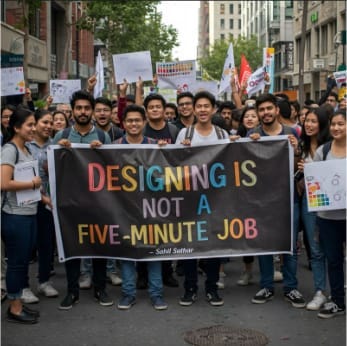We live in a world where visuals are expected instantly, mockups are requested overnight, and “quick changes” are assumed to be as effortless as flipping a switch. But here’s the truth: designing is not a five-minute job.
Whether it’s a social media post, a landing page, or a full-scale mobile application, design is a process. It’s deliberate. It’s thoughtful. And above all, it’s rooted in understanding.
The Myth of “Just Design It”
“Can you just quickly design this?”
Every designer has heard this phrase at some point. It sounds harmless — even flattering — as if you’re so talented that great design flows effortlessly from your fingertips. But this mindset minimizes the real work involved in crafting good design.
Design isn’t about placing pretty things on a canvas. It’s about solving problems. It’s about balancing clarity with creativity, function with form, and emotion with logic.
What Goes Into Design?
Design is not a single act — it’s a series of connected efforts, often invisible to those who aren’t directly involved. Here’s what’s happening behind the scenes:
1. Research and Understanding
Before a pixel is placed, a designer seeks to understand the user, the business goals, the context, and the pain points. Who is this for? What issue are we solving?
2. Conceptual Thinking
This is where creativity meets strategy. Sketches, user journeys, wireframes, moldboards — it’s all part of shaping the concept before building anything polished.
3. Visual Craftsmanship
Typography, color theory, layout, spacing, iconography, motion — every visual decision must align with both aesthetic principles and functional goals.
4. Feedback and Iteration
Design is rarely perfect on the first try. It requires critique, refinement, and adjustments. Each round of feedback reveals something new to improve.
5. Implementation and Handoff
A designer prepares deliverables for development, writes documentation, checks responsiveness, and ensures every detail is consistent.
Why This Mindset Matters
When design is treated as an afterthought or a five-minute task, the outcome suffers. Users feel it. Brands lose credibility. Products fail to connect.
But when time is given, not just to do design, but to think through design, magic happens. The result is intuitive, delightful, and valuable.
A Designer’s Time is an Investment
Designers don’t just give their time — they give their thinking, empathy, skill, and experience.
Instead of asking, “Can you quickly design this?”, ask:
What are we solving for?
Who will this impact?
How much time do we need to do it right?
Good design isn’t fast. And fast design usually isn’t good. But thoughtful, intentional design? That’s what creates a lasting impact.
Final Thoughts
Designing is not a five-minute job because it’s never just about the design.
It’s about communication. Clarity. Storytelling. Psychology. Accessibility. Empathy.
It’s about connecting the right dots — not rushing to draw them.
So the next time someone underestimates the process, remind them:
“Design may look simple, but simplicity is the result of deep, complex work.”

